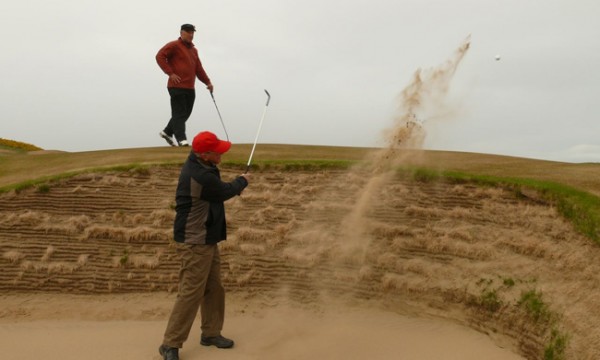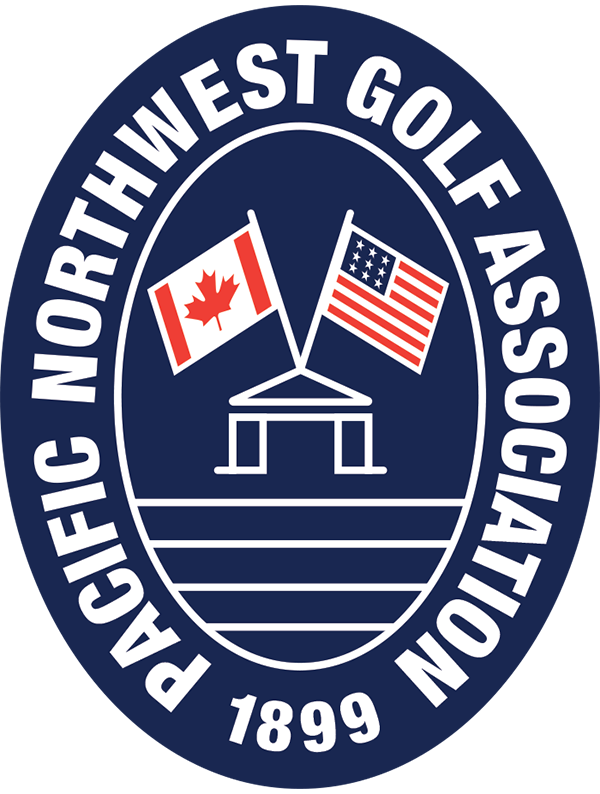Tales from the Fourth – the Magics Continues at Bandon Dunes

by Blaine Newnham
I get to do these kinds of things. Like drop a ball into the Road hole bunker and try to hit it out. You won’t believe me that I holed it, but I did.
Bandon Dunes Golf Resort will open its fourth course June 1, the mammoth Old Macdonald, a sprawling tribute to golf’s golden age of architecture. A Road hole, a Long, a Short, an Alps, a Cape, a Redan green, a Biarritz green.
Four of us got a test drive on all 18 holes a few weeks ago. We were the only players on the course. A caddie grabbed his stocking cap as we turned back into the southerly win.
“I’m getting goose bumps just thinking about the finishing holes,” he said to no one in particular.
Old Macdonald has that kind of credibility.
“I think it will be the best of the courses because it is so much fun I want to go right out there and play it again,” said another caddie.
While the crowds have quelled at the resort in deference to the economic conditions in which we find ourselves, there is genuine excitement over the addition of Old Mac.
There isn’t a tee time to be had for its official opening.
“I found my course,” said Jeff D’Amico, a long-hitting former major league baseball player who is now the head pro at Wing Point G&CC on Bainbridge Island, Wash. “I don’t even have to aim.”
Chambers Bay is a big golf course on 250 acres by Puget Sound. Old Macdonald is twice as big. The size of an average green is 12,000 square feet while the largest, at 21,000 square feet, has a gully in it.
Four of us played the course in late March, making the drive past the 22-acre practice area, through a grove of trees to the almost-finished clubhouse.
The first two holes are east of a large ridge, the third taking the player over it with their tee shot to view much of the rest of the course, the neighboring Pacific Dunes course and the neighboring Pacific Ocean. What you can’t see is the green.
Old Mac may be the caddie’s favorite – although many of them will tell you that they think Bandon Trails is the best – but the jewel of the resort will always be the wildly creative Pacific Dunes, while the most enjoyable and important is the first course, Bandon Dunes – without the beauty and playability of Bandon, there wouldn’t have been a Pacific or a Trails or an Old Mac.
My guess is that Old Mac, lacking the seaside drama, will be popular as a change of pace. The average players like me will like the wide-open venue because it is easier than the others, and the good players will like it because if it more difficult.
If that sounds strange, then try to make birdie on a green that measures nearly 100 yards from front to back.
If nothing else, Old Mac is different and a wonderful complement to the others. It is clearly a thinking man’s course, an enormous playfield of choices and strategies.
The Alps hole, No. 16, is played with a second shot over a large dune hiding a green. The location of the pin is noted by the positioning of a bowling ball on the top of the dune, like the famous Dell hole at Lahinch in Ireland.
The finishing hole is played to a massive punchbowl green that requires as much geometry as guile to solve.
But while the greens are enormous, there are areas around pin placements that are relatively flat.
“I tell players at Trails to read less break and putt the ball firmly,” said Jeff Brinegar, formerly the head pro at Trails and Pacific Dunes before getting the job at Old Mac.
“At Old Mac the greens are true. The last time I played it, I made everything.”
The cost – $220 during the high season for those staying at the resort – will be the same for all four courses. A second round on any of the courses is offered at $110, while a third round – if you’ve played the first two early enough and can still stand up – is on the house.
Seventeen of the holes reflect strategy that C.B. Macdonald used in designing many of America’s great early courses. The seventh hole climbs up to a spot overlooking the Pacific Ocean that designers Tom Doak and Jim Urbina are sure Macdonald would have relished drawing up himself.
These holes are not replicas. The Road hole has its famous riveted bunker to the left front of the green, but there is no hotel to hit over. And no road. Just a sharing of design features.
The course’s front side is par 34 and barely tops 3,000 yards while its back nine is par 37 and is 4,000 yards. Quirky, but somehow more authentic.
The comparable courses in Scotland might be the Old Course or Turnberry, the comparable here is right up the coast, Chambers Bay. We’re talking big courses with few if any forced carries, courses that magically work for players of all abilities.
Golf isn’t regressing in its new period designs, it is getting better. And the resort at Bandon Dunes, already judged as the best in the country, if not the world, is getting better.
“I’m afraid people will play Old Mac instead of Trails,” said Neal White, one of the members of our group. “Trails needs to be played. It’s that good.”
And so the Bandon babble continues late into the night. If you could only play one course…
Hopefully, there is more golf than that on your trip. Surely there are now more holes that need to be played.
Blaine Newnham is a former sports columnist and assistant managing editor for the Seattle Times. He covered the 1966 U.S. Open, following Ben Hogan around the Olympic Club. He covered his first Masters in 1987, when Larry Mize won it in a playoff with an unlikely chip shot. He covered the four majors of the “Tiger Slam”, when Woods won his four consecutive championships. In 2002, Blaine wrote a book titled “Golf Basics”.





